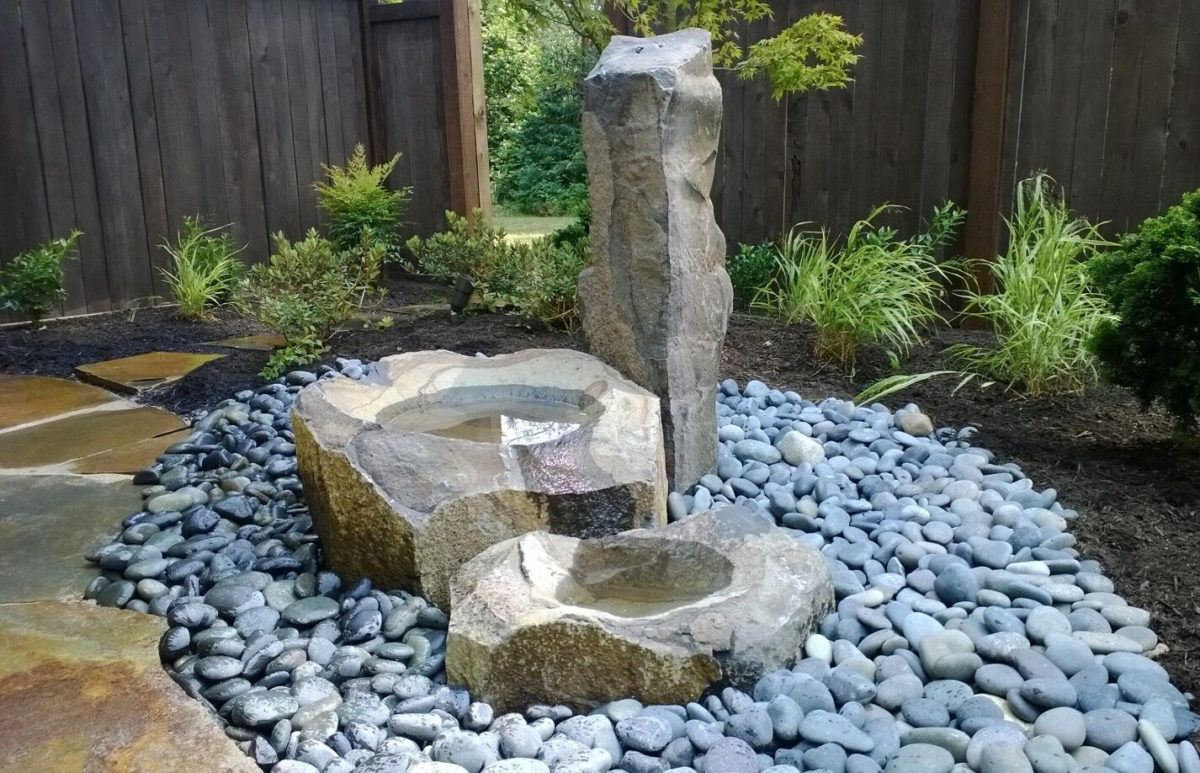
Water and stone can nourish your senses in a sanctuary.
At In Harmony, we design landscapes for social times as well as for solitude. We believe an important role of a landscape is to be a sanctuary or refuge. You may enjoy having a quiet place outside your home for meditation, healing or other purposes.
Jessi Bloom’s latest book Creating Sanctuary offers perceptive ideas about how to make these soothing spaces. Bloom is a well-known landscape innovator and educator.
“We all need sanctuary,” the book begins. “We need a place where we can feel safe, one that rejuvenates and refreshes us, somewhere we feel nourished and loved.”
The spirit of the land
To create a sacred space, you could begin by getting to know the spirit of the land. One of our designers could walk your landscape with you to help answer these questions.
- Soil: What is its condition, what type of soil is it, how much organic matter does it have, where does it drain well?
- Water: What are the sources of water, and where does the water go when it rains?
- Flora and fauna: What is already growing in the space? Which creatures are regular visitors?
- Sun and shade: Where does the sun hit at various times of day? Where would you like more sun?
Intentions
What are your intentions for the space? You may choose to create a space for prayer, healing, meditation, practicing yoga, relaxation, memorializing, enhancing creativity or other purposes.
Appealing to your senses
You may want to imagine how your sanctuary will appeal to all of your senses.
- Color and texture evoke different moods or emotions. Cool colors such as blue, green and violet tend to be calming, while hot colors such as red and oranges can be energizing. The textures of leaves and flowers stimulate the eyes and hands.
- Soothing sound could be the rustle of wind in leaves, grasses or wind chimes. It could be a rain chain or running water.
- Fragrance can be added through blossoms such as star jasmine, honeysuckle or Asiatic lilies.
- Taste could come from adding raspberries, strawberries, vegetables and/or herbs.
You could create a simple chart listing your needs, wants and desires for your space. This would provide useful information for an In Harmony designer to create a space that works for you.
Five steps to create your sanctuary garden
- Clear out the space. Clean out anything that might keep you from feeling calm and at peace there. This may include objects that are visually or mentally distracting. Or it could be plants that don’t fit the space, have wounds or structural issues, have been repeatedly malpruned or are nearing the end of their lives. You can may be able to donate unwanted plants to friends, family, a school or community group.
- Improve the soil. Use lots of organic mulch to add nutrients to the soil. Consider sheet mulching to quickly transform your space. Tread lightly so you don’t compact the soil. We use compost and mulch to ensure you have good soil to get your plants off to a healthy start.
- Manage the water. You may want to add ways to capture and cleanse the water, such as a cistern or rain garden.
- Provide wildlife habitat. Add native plants, diverse plant species, water and shelter to attract birds, pollinators and other wildlife. In Harmony’s practice is to select plants that meet these criteria.
- Build the plant layers. A natural plant community includes layers: a tall canopy of trees, shrubs and perennials, along with ground covers and mid-layer plants. We would design your sanctuary to include all of these layers for a resilient, easy-care landscape. And consider which colors and textures you would like to see in each season for year-round interest.
We can help create your space
We would be happy to talk with you about adding a sanctuary outside your own home. Contact us to start the design process with one of our landscape designers.
